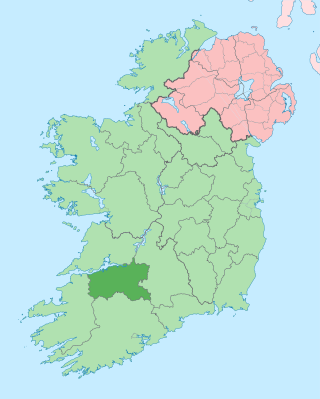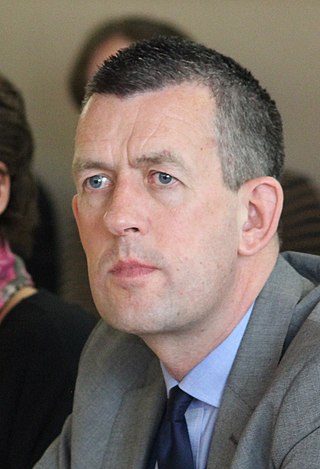
County Limerick is a western county in Ireland. It is in the province of Munster and is located in the Mid-West which comprises part of the Southern Region. It is named after the city of Limerick. Limerick City and County Council is the local council for the county. The county's population at the 2016 census was 194,899 of whom 94,192 lived in Limerick City, the county capital.
An alderman is a member of a municipal assembly or council in many jurisdictions founded upon English law. The term may be titular, denoting a high-ranking member of a borough or county council, a council member chosen by the elected members themselves rather than by popular vote, or a council member elected by voters.

Republican Sinn Féin or RSF is an Irish republican political party in Ireland. RSF claims to be heirs of the Sinn Féin party founded in 1905 and took its present form in 1986 following a split in Sinn Féin. RSF members take seats when elected to local government in the Republic of Ireland, but do not recognise the validity of the Partition of Ireland. It subsequently does not recognise the legitimacy of the parliaments of Northern Ireland (Stormont) or the Republic of Ireland, so the party does not register itself with them.

James Kemmy was an Irish socialist politician from Limerick, who started his political career in the Labour Party. He later left Labour, was elected as an independent Teachta Dála (TD), and founded the Democratic Socialist Party, which merged with the Labour Party in the 1990s.

The functions of local government in the Republic of Ireland are mostly exercised by thirty-one local authorities, termed County, City, or City and County Councils. The principal decision-making body in each of the thirty-one local authorities is composed of the members of the council, elected by universal franchise in local elections every five years from multi-seat local electoral areas using the single transferable vote. Many of the authorities' statutory functions are, however, the responsibility of ministerially appointed career officials termed Chief executives. The competencies of the city and county councils include planning, transport infrastructure, sanitary services, public safety and the provision of public libraries. Each local authority sends representatives to one of three Regional Assemblies.

John Daly, was an Irish republican, and a leading member of the Irish Republican Brotherhood. He was uncle to Kathleen Clarke, wife of Tom Clarke who was executed for his part in the 1916 Rising and who was a leading member of the IRB, and her brother Ned Daly who was also executed in 1916. Daly briefly served as a member of the British Parliament but was resented for having previously been convicted for treason against the British state. Daly also served as Mayor of Limerick for 3 years at the turn of the century.
An election to the County Council of London took place on 5 March 1910. It was the eighth triennial election of the whole Council. The size of the council was 118 councillors and 19 aldermen. The councillors were elected for electoral divisions corresponding to the parliamentary constituencies that had been created by the Representation of the People Act 1884. There were 57 dual member constituencies and one four member constituency. The council was elected by First Past the Post with each elector having two votes in the dual member seats.
An election to the County Council of London took place on 6 March 1919. It was the tenth triennial election of the whole Council. The size of the council was increased to 124 councillors and 20 aldermen. The councillors were elected for electoral divisions corresponding to the new parliamentary constituencies that had been created by the Representation of the People Act 1918. There were 60 dual-member constituencies and one four-member constituency. The council was elected by First Past the Post, with each elector having two votes in the dual-member seats.

An election to the County Council of London took place on 2 March 1922. It was the eleventh triennial election of the whole council. There were sixty dual member constituencies and one four member constituency, making a total of 124 seats. The council was elected by First Past the Post with each elector having two votes in the dual member seats.

Maurice Quinlivan is an Irish Sinn Féin politician who has been a Teachta Dála (TD) for the Limerick City constituency since the 2016 general election. He was appointed Chair of the Committee on Enterprise, Trade and Employment in September 2020.
The Leeds municipal election was held on 8 May 1969, with one third of the councillors up for election. The Conservative incumbent in Armley had defected to Independent Conservative in the interim and hoped to defend it as such.
The Leeds municipal elections were held on 14 May 1971, with one third of the councillors up for vote including a double vacancy in Talbot.
The Leeds municipal elections were held on Thursday 14 May 1954, with one third of the council up for election.
The municipal elections for Leeds were held on Thursday 7 May 1964, with one third of the council seats up for the election. Labour had gained a seat from the Conservatives in the interim.
The Leeds municipal elections were held on Saturday 2 November 1946, with one third of the council and vacancies in Burmantofts and Farnley & Wortley to be elected. A handful of wards - Armley & Wortley, Burmantofts, Holbeck North, Hunslet Carr & Middleton and Osmondthorpe - went uncontested.

The Local Government Reform Act 2014 is an act of the Oireachtas which provided for a major restructuring of local government in Ireland with effect from the 2014 local elections. It merged some first-tier county and city councils, abolished all second-tier town and borough councils, and created a new second tier of municipal districts covering rural as well as urban areas. It also provided for a plebiscite on whether to create a directly elected executive Mayor of the Dublin Metropolitan Area although this provision was not activated. The act was introduced as a bill on 15 October 2013 by Phil Hogan, the Minister for the Environment, Community and Local Government, and signed into law on 27 January 2014 by President Michael D. Higgins. Most of its provisions came into force on 1 June 2014.

Limerick City and County Council is the authority responsible for local government in County Limerick in Ireland. It came into operation on 1 June 2014 after the 2014 local elections. It was formed by the merger of Limerick City Council and Limerick County Council under the provisions of the Local Government Reform Act 2014. As a city and county council, it is governed by the Local Government Act 2001. The council is responsible for housing and community, roads and transportation, urban planning and development, amenity and culture, and environment. The council has 40 elected members. Elections are held every five years and are by single transferable vote. The head of the council has the title of Mayor. The city and county administration is headed by a Chief Executive, Pat Daly. The administrative centre is City Hall, Limerick, with other civic offices at Dooradoyle. Following a plebiscite in 2019, Limerick is due to become the first local authority in Ireland with a directly elected mayor.

An election to Limerick City and County Council took place on 23 May 2014 as part of that year's Irish local elections. 40 councillors were elected from six electoral divisions by PR-STV voting for a five-year term of office. This is a new local authority which was formed out of a merger from the abolished Limerick City Council and Limerick County Councils.

The 1901 Dublin Corporation election took place in January 1901 in five wards added to Dublin city under the Dublin Corporation Act 1900. The twenty councillors elected to these seats sat in addition to the sixty who had been elected in 1899, bringing the council size to 80.










